






This section has programs that can be typed into Bally BASIC. These programs may have appeared in the Arcadian, or Cursor at some point, if so, use the newsletter versions! These are here for completeness.
(Edward Oswald)_tn.jpg)
|
24 Hour Digital Clock. By Edward Oswald. 1982. Unpublished "Arcadian" Submission. |
_tn.jpg)
|
Arcadian Game Enhancements - By Richard Houser Enhancements by Richard M. Houser for games published in the volume 2 of the Arcadian. The games are "Mastermind" (Arc 2-53) and Subsearch (2-83). As far as I can tell, these enhancements were never published. |
(John Collins)(BASIC Listing)_tn.jpg)
|
Bally's Alley By John Collins. Type-In Listing for Bally BASIC. 1980. An adventure game; one player. Game can last for days or weeks; can save at any point for restart; can go in nine directions; find the ten treasures and return to house; can only carry four treasures at one time. Each move subtracts a point. A magic word-sound-color will be helpful. Bally's Alley was offered for sale on tape in the classified ads section of the Arcadian 2, no. 7 (May 19, 1980): 66.
|
(John W Rhodes)(Creative Computing)_tn.jpg)
|
Bally Artillery By John W. Rhodes. Type-In Listing for Bally BASIC, Creative Computing, August 1982, Pages 191-192. John Rhodes writes: "I particularly liked the artillery game that Compucolor called 'Shoot.' This game generates a random terrain display and wind factor and positions two artillery emplacements on the screen so that two opponents can take turns trying to obliterate each other. Eventually I resolved that I either had to buy a Compucolor or program this game on my Bally. I chose the latter. "This turned out to be quite a challenge with less than 2K of memory and integer-only Tiny Basic. But the Bally Basic is quite sound for game programming and easy to work with. The greatest difficulty was finding an integer sine routine, but after searching the magazines I found a routine to adapt to my purpose. I started out using a full ballistic equation, but soon found by experimentation that I could use an approximation. This eliminated an integer square-root routine and added speed in the bargain. "I spent approximately two months writing, debugging, and fine-tuning the program, but it was worth the effort." This program isn't easy to read, so I tried to enhance each column of the BASIC program in case anyone wants to type this program in so that it can be archived. |

|
Bally BASIC Demo Cartridge - Bally This is a printout of the Bally BASIC program that is contained in the Bally BASIC Demo cartridge. |
| Bally BASIC Editor | Bally BASIC Editor. Released by Perdido Key Home Computers. by Jim Dunson. A Bally BASIC utility program to change, delete or insert a Bally command word or a character in mid statement. |
(Bob Wiseman)(Letter-LISTing-Doc)_tn.jpg)
|
"Bally Forth." By Bob Wiseman. January 12, 1981. Bally BASIC From Bob Wiseman's notes: This is a simple Forth-like language which is interpreted by Bally BASIC. It is very different from BASIC and some mental reprogramming may be necessary. I hope that I offend no one by calling this "Forth". The similarities are present but are limited. Please understand that this is an eensy-weensy version. Nonetheless, for those of you wishing a new challenge, a change of pace from the vulgarities of Tiny BASIC, here is a new language that you can fret over. This language operates on a stack principle. You do not have any data names (like "a"), you have a stack of data, much like a stack of playing cards. First you enter your program and your program creates and manipulates this stack of numbers. Each number in the stack must be a number that is valid in Bally BASIC. These are stored in the at-sign string, but more about this later. First, let us look at the operations that are available. Archiving Note: The scanned "Bally BASIC" document includes the complete documentation on how to use "Bally Forth." |
(Bally BASIC and ML)_tn.jpg)
|
Bootstrap for ML. By Brett Bilbrey. 19xx. This program is a bootstrap that loads a machine language program into RAM from a :RUN command and then proceeds to execute it. The specific example pertains to the Music Demo [Brett is probably referring to the Machine Music Demo]. Some values will change for different programs, of course. |
| Bowling | Bowling. By John Collins. June 1, 1979. This BASIC program listing is in rough shape. There are some brief comments alongside the listing with curt instructions. |
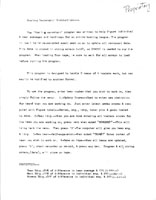
|
Bowling Secretary - New Image. |
(James Wilcher)_tn.jpg)
|
Capture the Dog - James Wilcher. From the submission letter to the "Arcadian:" "To play the game you're moving up the screen under the Computer's control and you use your joystick to move in right or left [directions] and try to Eat the Dogs without running into the walls."
|
(THADD PRO)(BASIC Listing)_tn.jpg)
|
Caterpillar and Okiedada. By THADD*PRO (Tim Henson and David Dalke) July 15, 1983. Caterpillar: Niagara B.U.G. Bulletin, 1.7 (September 6, 1983): 8-10. Caterpillar: Arcadian, 6, no. 10 (Aug. 24, 1984): 95. Okiedada: Previously Unpublished. This is the original program submission letter (and BASIC type-in program listings) to the Arcadian for the games Caterpillar and Okiedada. Caterpillar is a game of luck and skill. You control the direction of travel of your caterpillar and try to eat the floppy disks that appear on the screen. Be careful- if you touch any walls or the trail that you leave your head gets crushed and you die. You also die if the timer at the bottom of the screen runs out. There are ? different screens and each one gets harder. Scoring works by the more time you have left the more points you score. In Okiedada you try to defend your city from falling meteors. You can also accumulate points by hitting the mini-space ship in the upper-left corner of the screen, but in doing so you may sacrifice a hit on your force-field. There is a bonus point meteor that is signified by a series of tones that also falls. Use your joystick for target-control movement in your trigger for firing. (Hint - At 3,000 points exactly shoot the mini spaceship!) |
(Creative Computing)(July 1983)_tn.jpg)
|
Cavern Quest. By Bruce Jaeger. Creative Computing 9, NO. 7 (July 1983): 222, 224-225. This is a text adventure game that uses the joystick for input from the player. The game is large, random and pretty fun (if you map it!). "The scenario of the game is straight-forward. Jesse James, the Robin Hood or Attila the Hun of Missouri (depending on your point of view), has hidden a treasure deep in a cave, and you want to go in, find it, and bring it out. That's it. No magic birds, sword-wielding ogres or dissembling oracles. Not only would that have been quite a task in 1800 bytes, but it turns out that a simple, realistic exploration of a three-dimensional cave is difficult enough, thank you. The cavern passages do not form a traditional maze, as there is often more than one path to the treasure, and any path is liable to loop back on itself-sometimes in an inexplicable way. Make a map." This version has been archived in "AstroBASIC" (2000-baud) format. There is also more information about the program in the program download area.
|
_tn.jpg)
|
Critter By Brett Bilbrey Release: December 1980 Source: Arcadian, Vol. 3, Page 13 (No explanation), Cursor, Vol. 2, Page 65 (with Explanation) This program will place a Space Invader-type "critter" on the screen that will bounce around from top to bottom and side to side without disturbing anything on the screen. His speed is controlled by hand control #1. This is a machine language program that uses the Bally/Astrocade's Vector motion routines that contained on the on-board ROM. The Bally BASIC program (not AstroBASIC!) and the machine language program are included.
|
_tn.jpg) |
Decode. By John Collins (Collins Computer Company). ARCADIAN 2, no. 7 (May 19, 1980): 66. [Advertisement] For the Bally Arcade/Astrocade and Bally BASIC. This program description is from a listing of programs by John Collins: "Decode is a utility program. This program will decode information stored in memory. You enter the decimal location of memory and the binary # and the hexadecimal # for that location and the next highest location is printed out. This utility program is useful for machine language programming. It is also useful for understanding how the Bally works." The following advertisement for "Decode" seems to only appear on page 66 of the May 1980 issue of Arcadian: "Checkers, Chess Board, Hangman, Bowling, Bally's Alley (an adventure program) O-hello, Inspector Clue-so, Decode are the games available from John Collins, 713 Bradford Dr., Ft. Walton Beach, FL 32548, costing: $6 per program, $8 for two, $9 for three, or $10 for four, all on his tape. More data, listing Info, etc., for an SAE."
|
(Program Listing and Description)_tn.jpg)
|
"Duck_Hunter" By Loius Gubernatis A one player game. Object of the Game: Hunter to shoot down 10 ducks before 10 ducks fly by. Every time you hit a duck, "Ol' Smoke" will retrieve it for you. The ducks fly by at random speeds, so holding the trigger is of no real help. If 10 ducks fly by you'll get the "BIRD". TR(1) - Controls firing the gun and restarting the game. KN(1) - Controls position of gun. |
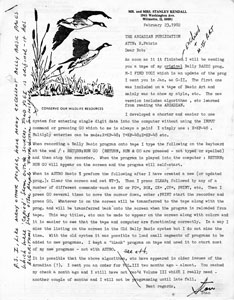
|
Find Yogi and Ever Changing Cross. By Stanley Kendall. 1982. Source: Handwritten Bally BASIC Type-In Program Listings. This four-page document contains a typed letter to Bob Fabris and two BASIC programs: a game called "M-I - Find Yogi" and video art called "M-II - Ever Changing Cross." It's unclear if these programs are for Bally BASIC or AstroBASIC. These seem to be early versions of the programs. For example, "Ever Changing Cross" was later expanded for Blue Ram BASIC. These are brief notes from the type-in listing for "M-II - Ever Changing Cross:" "A short but attractive program. Design many attractive variations can be made of this program by changing BOX parameters. [...] Program could easily be changed to input different BOX and STEP sizes from the keyboard. The variations and different designs are extensive." |
(Alternative Engineering)(Docs)_tn.jpg) |
"Grafix Tablet Simulator" By Alternative Engineering. 1982. ARCADIAN 4, no. 10 (Aug. 06, 1982): 95-97. VIPERsoft or Blue RAM BASIC, 2000 baud. The "Arcadian" newsletter also contains detailed instructions for this program. |
(Letter and LISTing)_tn.jpg) |
"Graphics Quadruplicate" By Jim Dunson. 198x. Submitted to Arcadian, but previously unpublished. AstroBASIC. |
(Jim Marselle)_tn.jpg) (Jim Marselle)_tn.jpg)
|
"Graphic Utility Subprograms" By Jim Marselle. October 23 1980 / February 11 1982. Bally BASIC. Two letters to the "Arcadian" newsletter that talk about Jim Marselle's Graphic Utility Subprograms. These include detailed instructions and type-in listings. These Bally BASIC programs are available for download. |
(Fred Rodney)(AstroBASIC)(LISTing and Docs)_tn.jpg)
|
Gravity By Fred Rodney. 1984. Submitted to Arcadian, but previously unpublished. |
/Haunted House (New Image)(Instructions)_tn.jpg)
|
Haunted House By New Image. 1981, TAPE #SG1. These are the program instructions and BASIC listings for New Image's Haunted House. This game is very unusual because it is made up of nine different loads, each of which is a separate BASIC program. "Come on in!!! "You have just entered the Haunted House. To win the game, you must find a way to get out (the door has locked behind you). You may enter any of 8 rooms in the house. In the rooms you will have the chance to examine six different items. One of the items in one of the rooms will lead you out. Also, at times you will receive clues, but you have to figure out what they mean. (We're not telling.)" |
_tn.jpg)
|
Jailer Problem, The By Fred Rodney. May 1, 1983. Submitted to Arcadian, but previously unpublished. Fred Rodney writes in a letter to Bob Fabris, editor or the "Arcadian" newsletter: "This is a listing in AstroBASIC of the 'Jailer Problem' in the June 1983 issue of Popular Computing, page 211. The Astrocade takes 2.75 minutes to complete this problem. I figure that the Astrocade does about 485 computations. That equals about 187 computations per minute or 3 per seconds. Each computation takes 333 milliseconds." The program, as Fred said, is based on "The Jailer Problem," a puzzle posed by "Popular Computing" in the June 1983 issue. Here's the magazine's description: To recap from last month: an eccentric jailer makes a complicated amnesty offer to his 100 inmates. Every second, he reverses the status of certain cell doors from open to closed or vice versa. After one second, he switches cells whose numbers are multiples of 1 (all of them are opened). After two seconds, cells whose numbers are multiples of 2 (even-numbered cells) are switched. After three seconds, he switches cells whose numbers are multiples of 3, and so on. He repeats this process for 100 seconds. If a cell door is open after the last switch, the con in that cell goes free. Now, as we asked last month, which inmates will benefit from this amnesty offer? The key to the solution of the problem is the recognition that a cell is switched once for each number that divides evenly into the cell number. For example, cell number 6 will be switched at seconds 1 (open), 2 (closed), 3 (open), and 6 (closed)-- these are the divisors of 6. If a cell number has an even number of divisors, then that cell will be closed when all the switching is over. Only cells whose numbers have an odd number of divisors will be open after all is said and done. The program in listing 1 [not included here] finds and lists all the cells that will be open after the 100-second switching process. Why not type it in and try it out before continuing? Did you notice the rather striking pattern to the cells that are open? Next time I'll offer an elementary mathematical explanation of why we get such an elegant result. |
(Chuck Thomka)(1979)_tn.jpg)
|
Leaning Aid for "&" Command By Chuck Thomka. January 28, 1979. Submitted to Arcadian, but previously unpublished. A five-page program that is purely Chuck's own concoction. This program uses all but about 150 bytes of memory and is somewhat involved, but is informative as to the workings of all the possible '&' commands. |
| King and Emperor | King (1) and Emperor (2) By Richard Houser. 1982. Two BASIC programs with documentation. These are from Richard's printouts. |
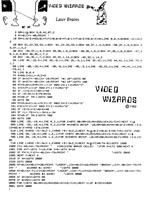
|
Lazer Brains - By Video Wizards. |
(Matt_Giwer)(BASIC_Listing)_tn.jpg)
|
Life IV. By Matt Giwer. 1980. Source: Handwritten Bally BASIC Type-In Program Listing and Documentation. "Life IV" by Matt Giwer is a Bally BASIC program first advertised in ARCADIAN 2, no. 6 (Apr. 25, 1980): 56. It was originally available on cassette or open reel tape with documentation for $5.50. This is a handwritten six-page document and BASIC listing. Matt, from Annandale, Virginia, writes, "Enclosed is the description, listing, documentation, initial data and an ad [for 'Life IV']. Not only is it slow but addicting. I let it run overnight. Every time I've tried to improve the program there is some error in functioning that is traceable to the cursor. Without the cursor the game is less interesting. A machine language version is needed. "Note I use a 30x35 array and a 60x70 is possible. The entire display array could be used to store 1s and 0s. [...] The screen is split left and right to display the present and future generation. The current generation is scanned with each location cursor provided for reference." |
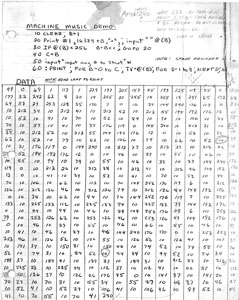
| Machine Music Demo By Brett Bilbrey. Source: Hand-written Bally BASIC Listing. This original photocopy looked rough, so the program was scanned-in using grayscale so that it is easier to read the right-most column which was re-written in light pencil. This is the best scan that is possible from the source material. The music is originally from the cartridge #6001, "Dealer Demo." The author of this program is not noted on this paper, by Brett confirmed on December 13, 2010 that this is his program. He said, simply, "Yea, that's my program. :-)"
|
/Micro_Mind_Reader_(1979)(DK_Calhoun)_tn.jpg)
|
Micro Mind Reader. D.K. Calhoun. October 20, 1979. Source: Handwritten Bally BASIC Type-In Program Listing. This seems to be an unpublished program submission to the Arcadian newsletter. The program is described in its BASIC listing as: "Think of a number between 1 to 31, and I'll tell you what it is. |
(Jan 1979).jpg)
|
Modified Player Piano for Learning Aid on the &16 - &23 Commands By Chuck Thomka. January 5, 1979. Submitted to Arcadian, but previously unpublished. A single-page modification to an existing Bally program which allows easy and quick changes to '&16' through '&23 commands [the sound ports]. |
(Bally_BASIC)_tn.jpg)
|
Music Program (Star Wars Example). By Brett Bilbrey. Music by Marion Nelepa. Bally BASIC. 1980. This load program puts data into RAM (.) statements. The music from Star Wars is included as data to be input into the main program. This appears to be an early version of "Three Voice Music Assembler" printed with the Star Wars and Chopsticks music as examples in CURSOR 1, no. 3 (March 1980): 17-19. In 1981, "Three Voice Music Assembler" was reprinted in the "AstroBASIC" manual. |

|
Music Decomposer - Richard C. Degler. This program is written for Blue Ram BASIC 1.1, which means that it requires extra RAM. The program changes MUSIC STRINGS from cartridge format to AstroBASIC format. |
| New Sub Search | New Sub Search By Ron Picardi. |
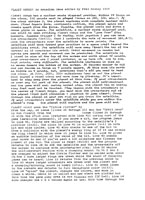
|
Planet Mongo - Fred Rodney. Paul Thacker says, "This is one of the best unpublished Arcadian submissions I've seen. It was submitted late in the Arcadian's lifecycle, so maybe it just got lost in the shuffle. Try to track the satellite's movements with the cursor. Don't aim for where it is; aim for where it's going." This type-in program (which HAS been archived from tape), included a letter from Fred to Bob Fabris, the game's documentation and an explanation of how the program works. |
_tn.jpg)
|
Record Keeping and Big Six Gambler. By Allen W. Skaggs. 1983/1984. Source: Bally BASIC Type-In Program Listings. This four-page document was probably sent to Bob Fabris, the editor of the "Arcadian" newsletter, sometime in the summer of 1984 after one of the programs was updated. It contains a letter and two BASIC programs for Bally BASIC/AstroBASIC. The first title is properly called "Record Keeping for AstroBASIC with Blue RAM Memory." According to the notes in the BASIC listing, this program was previously known as "Home Improvements" and was written on April 21, 1984 and revised for the 16K Blue RAM on July 9, 1984. Allen writes, "Use this program to store and retrieve auto costs, home improvements, computer software, record albums, etc. It is written to use the added 8K of space accessible by AstroBASIC. This could be modified to suit many needs. This program will also run in Bally BASIC and [Blue Ram BASIC]." The full name of the second program is "Big Six Gambler for One," which was written on February 2, 1983. Allen converted this game from "More BASIC Computer Games" by David Ahl. Allen says, "I have altered the original concept only slightly in this AstroBASIC version." The game starts by asking you how many numbers you want to bet on. You can use up to three. |
/Rotate%20(1984)(Robert%20Newman)(AB)(BASIC%20Listing)_tn.jpg)
|
Rotate - Robert Newman. "Rotate" is a sort of 2-D Cube plus "15-puzzle," where scrambled letters have to be placed in alphabetical order by rotating a 2x2 square segment within the total board. The BASIC listing was sent to the "Arcadian" by Robert Newman on September 7,1982-- but not published until two years later in the October 1984 issue. The nine-page program listing and description also has the complete play directions. The program and listing are described in GREAT detail, giving an understanding of exactly how the program works. It may be the most detailed AstroBASIC listing and description ever sent to the "Arcadian." |
(Brett_Bilbrey)_tn.jpg) |
Screen Display with Memory Save. By Brett Bilbrey. 198x. This program is from the Bob Fabris Collection. It seems to be previously unpublished. This routine places by actual HL location. This routine will display 11001100 on the screen as 1010. Inputs: Takes Byte in Accumulator and places on screen at HL. This is NOT a BASIC program, but it was probably meant to be input into BASIC using Brett's ML method detailed in the "Peek and Poke" manual; thus it has archived into the BASIC area. |
(Guy McLimore Jr)(BASIC Listing)_tn.jpg) |
Self-Portrait: A Graphics Demo. By Guy McLimore, Jr. April 10, 1979. Hand-written BASIC listing from an unpublished ARCADIAN submission. This program draws a simple Bally Arcade unit. |
(David Stocker)_tn.jpg)
|
Set I - Games and Fun By Dave Stocker. 1979. This set includes the following games:
|
(David Stocker)_tn.jpg)
|
Set II - Video Art By Dave Stocker. 1979. This set includes the following video art programs:
|
(300 Baud).jpg)
|
Sicko-Therapy II - New Image. To avoid trouble reading the program listing, the printout was scanned twice (once in B&W and once in grayscale). |
| Star Trek |
Star Trek - Author unknown. Very rough. |
| Two_BASIC_Programs | Hex Memory List and Wave Maker - By David Marlow. Hex Memory List and Wave Maker. |
(Stan W. Heinz)_tn.jpg)
|
Three BASIC Programs. By Stan W. Heinz. 1980. Three programs for Bally BASIC ported or enhanced by Stan W. Heinz. These were sent to the "Arcadian" newsletter on August 12, 1980. The three programs are:
|
(Scott Walpole)(Letter and LISTing)_tn.jpg)
|
"Treasure Hunt" By Scott Walpole. 1983. This is an unpublished "Arcadian" submission found in the Bob Fabris collection. It was submitted on May 25, 1983 to the newsletter for consideration for the $100 monthly programming contest. "Treasure Hunt" is played on a 9x15 grid. Hidden under the squares in the grid are objects randomly placed by the computer at the beginning of the game. Each player, in turn, selects one square by moving the marker with the joystick and uncovers it by pulling the trigger of his hand control. The object of the game is to first find four hidden "keys" represented by the numbers 1, 2, 3, and 4. |
| Video Instructions for XB | Video Instructions for XB (Extended BASIC) - By Alternative Engineering. A program that gives "video instructions" and demonstrations on the new functions of Extended BASIC. |
